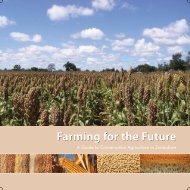Restoring the Soil - Canadian Foodgrains Bank
Restoring the Soil - Canadian Foodgrains Bank
Restoring the Soil - Canadian Foodgrains Bank
You also want an ePaper? Increase the reach of your titles
YUMPU automatically turns print PDFs into web optimized ePapers that Google loves.
72Green Manure/Cover Crop SystemsAsian Green Manure/Cover Crop SystemsBangladeshS65. Various crops/lablab bean. Land-hungry Bengalis often plant a few seeds oflablab beans (known <strong>the</strong>re as “hyacinth beans”) right next to <strong>the</strong>ir houses, so <strong>the</strong> beanwill grow up and cover <strong>the</strong> roof of <strong>the</strong> house. The seeds are eaten as a pulse, and <strong>the</strong>greenery is spread across <strong>the</strong>ir fields as fertilizer. Probably hundreds of thousands ofBengalis use this traditional system.ThailandS66. Citrus/mimosa. Spineless Mimosa species are grown near <strong>the</strong> town of ChiangMai as a cover crop under citrus trees. Probably only 50 to 100 people use thisintroduced system.S67. Citrus/centrosema. Centrosema pubescens is grown under citrus trees near ChiangMai as a perennial gm/cc, as well as for animal fodder. Perhaps a hundred farmers usethis system.S68. Citrus/cowpeas. Cowpeas are also grown as a cover crop under citrus. Very fewfarmers are as yet using this introduced system.S69. Maize/rice bean-2. Rice bean is relayed into maize fields a month or two before<strong>the</strong> maize is harvested. Then <strong>the</strong> rice bean continues to grow throughout much of <strong>the</strong>dry season. The rice bean is grown partly to fertilize <strong>the</strong> soil, partly to produce <strong>the</strong>rice beans as a cash crop, and partly to keep <strong>the</strong> soil covered during <strong>the</strong> dry season forbetter weed suppression and protection of <strong>the</strong> soil. The system also reduces <strong>the</strong> loss ofsoil nitrogen and, in many cases, allows farmers to use zero tillage (reducing costs onceagain). 28 Two or three hundred farmers use this system that was recently developed byfarmers.S70. Maize/cowpea-2. The cowpea is relayed into maize, as is done with <strong>the</strong> rice beanin S69. Most of <strong>the</strong> same farmers who use S69 also use this one, just alternatingbetween one legume and ano<strong>the</strong>r in different years.S71. Maize/lablab bean-3. The lablab bean is relayed into maize, just as it is done withrice bean in S69 (Photo 28). Two or three hundred farmers use this system.LaosS72. Upland rice/pigeon pea. Pigeon pea (Cajanus cajan) is planted at <strong>the</strong> same timeas upland (non-irrigated) rice, at a rate of about one seed every 1.5 to 2 m in eachdirection. Thousands of farmers use this traditional practice in nor<strong>the</strong>rn Laos.28Prinz, Klaus and Somchai Ongprasert, “Relay Cropping as an Improved Fallow in Nor<strong>the</strong>rn Thailand”, Unpublished.
















